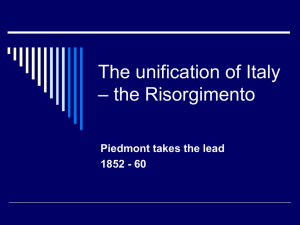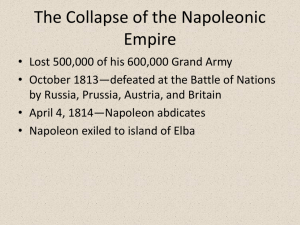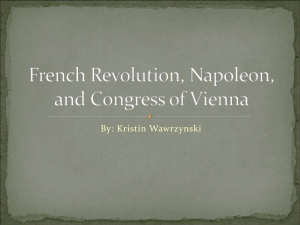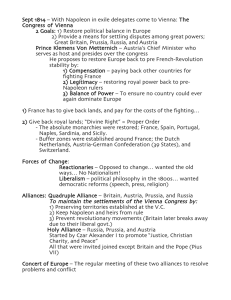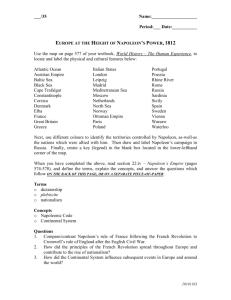The Unification of Italy - Oak Park Unified School District
advertisement
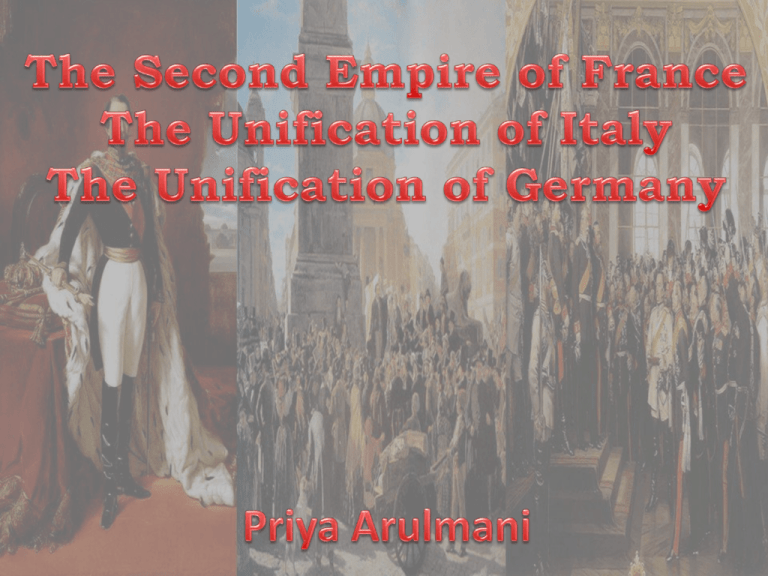
Click on the topic you want to see! Unification of Germany France’s Second Empire Unification of Italy Feb. 23: Abdication of LouisPhilippe; formation of the Second Republic Dec. 20: Louis Napoleon elected president of the Second French Republic March 27: France and Britain declare war on Russia leading to the Crimean War Jan. : Expedition to Mexico sent Feb.–April: Congress of Paris 1848 1851 Dec. 2: Louis Napoleon’s coup d’etat 1852 1854 1856 1859 Dec. 2: The Second Republic named the Second Empire; Louis Napoleon crowned Emperor Napoleon III May 3: Declared war on Austria 1860 1862 1870 April 8: France and Britain declare war on China Franco-Prussian War; ends with French defeat and the fall of the Second Empire Louis Napoleon • Nephew of Napoleon I • Elected president of France’s second republic after abdication of Louis Philippe • 1851: tried to get the Chamber of Deputies to pass a law that allowed for a second presidential term – Law was rejected • December 2, 1851: Coup d’etat – Paris put in state of siege – 200 Deputies arrested – Troops in Paris streets • Much resistance across France – hundreds killed, 20,000 arrested • Louis Napoleon decreed presidency is 10 years – Also reinstated universal male suffrage Emperor Napoleon III by Franz Xaver Winterhalter Almost unanimous reelection of Louis Napoleon • • December 2, 1852: crowned Napoleon III, Emperor of France Rebuilding of Paris by Georges Haussmann The Empire Under Napoleon III • • • • • • • Authoritarian government Paid much attention to public opinion and used propaganda Supported by businessmen, Catholic church, most monarchists, local notables, peasants Sponsored programs for economic growth and social welfare Supported inventors and technological advancement Used tax incentives to stimulate investment Rebuilding of Paris by Haussmann Liberalism in the Empire • • Commercial treaty with Britain to allow free trade Enlarged role of legislature – • • By 1870 – full parlimentary system Granted freedom of press and assembly and right to strike Supported Workers Organizations The Crimean War and the Congress of Paris • • • • • • • • • 1854-1856 France and Britain allied against Russia over power struggle in Middle East Fought more for prestige Battle fought in present day Crimea because it was most convenient battleground Had support and troops from Piedmont against Russia After a year of fighting, Austria threatens to join France and Britain Russia sues for peace and they meet in the Congress of Paris France, Britain, Russia, and Ottoman empire sign Treaty of Paris Treaty of Paris: • Black Sea is neutral territory • Danubian territories (Moldavia and Walachia, called Romania after 1859) given as semi-independent territories to Ottoman empire • Christians in Ottoman empire given better status • Ottoman empire boundary returned to as it was before the war (loss to Russia) Back to Map Expedition of the Thousand Feb. : Formation of the Roman Republic Cavour made Prime Minister of Piedmont July 3: Roman Republic defeated by French 1849 1850 March: Mazzini arrives in Rome and is elected head of triumvirate; Victor Emmanuel II crowned King of Piedmont 1852 April 12: Pope returned to Rome Aug. – Sept.: Garibaldi becomes Dictator of Naples Sept. 18: Garibaldi and Emmanuel unite north and south Italy April 29: Austria declared war on Piedmont; Napoleon joins Piedmont against Austria 1854 1859 1860 July: Cavour resigns out of shame of Austria’s victory Piedmont sends troops to aid of French in Crimean War Jan.: Cavour returns as Prime Minister 1861 March: Victor Emmanuel II crowned King of Italy The Roman RepublicGuiseppe andMazzini Mazzini • The republic lasted from Feb. – July 1849 • The pope was driven out of Rome during the revolts of 1848 and Rome became a republic • They called in Guiseppe Mazzini and he became an honorary Roman citizen and the head of the triumvirate – Mazzini wrote letters to Pope Pius IX to unify Italy, but was ignored • The pope asked other Catholic countries for help and the republic was crushed by the French • Mazzini returned to England and formed the Friends of Italy which supported unification • He sentPius Orsini Pope IX to France to assassinate Napoleon III but that plot failed • After Austria regained control, Mazzini returned to exile Cavour and Piedmont Camillo Cavour • • Cavour became prime minister of Piedmont in 1852 Reasons for Piedmont’s strength: – Military strength – Conservative philosophy – Stable government with a parliamentary system and King Victor Emmanuel II • Cavour added to this by: – Implementing free trade – Managing Piedmont’s finances – Building railroads • • • Piedmont began to take a bigger role in trade to draw trade away from Austria Cavour encouraged people to participate in government and shaped public opinion against Austria and in favor of unification using propaganda His goal was to make Piedmont the center of the Italian resorgimento (resurgence) Cavour and Piedmont Lombardy • Cavour met with Napoleon IIIVenetia to secure alliances with a strong European power against Austria • France got Nice and Savoy in return for allying with Piedmont Piedmont • Austria had control of Lombardy and Venetia, but Lombards and Venetians fled to Piedmont • 1859: Austria declares war on Piedmont and France joined Piedmont against Austria soon after • Piedmont received Lombardy after the war, but all other Italian states remained the same • Napoleon III did not approve of a unified Italy, so it agreed with Austria and did not give Piedmont Venetia as well • Cavour resigned as prime minister out of shame of Piedmont’s loss • He returned the following year The Expedition of a Thousand and Guiseppe Garibaldi • After being exiled for revolutionary activities, Giuseppe Garibaldi went to South America to fight for democratic causes • 1848: He returned to Italy and took part in the revolt, the Roman Republic and the Expedition of a Thousand • 1859: gathered volunteer soldiers from Genoa, Lombardy, Venetia, and Romagna and set sail for Sicily • The Kingdom of Two Sicilies was occupied in two months and Guiseppe Garibaldi Garibaldi headed to mainland Italy • He made to attack Rome, but Cavour started riots in the Papal States to draw Garibaldi away from Rome and prevent France and Austria invading and ruining the unification plan Teano Handshake marking the Unification of Italy • 1860: two thirds of the Papal States joined Piedmont • The Piedmont army went south to meet up with Garibaldi where he shook King Victor Emmanuel’s hand and unified North and South Italy • Only states remaining were Rome and Venetia Annexation of Venetia and Rome • Napoleon III protected Rome because Catholics were against annexation • Risorgimento Austrian troops occupied Venetia • 1866: Italy got Venetia during the AustroPrussian War for supporting the Prussians against Austria King Victor Emmanuel II • 1870: Rome was annexed during the FrancoPrussian War when French troops withdrew • Rome was made the capital of the Kingodm of Italy with King Victor Emmanuel II Back to Map Jan: German Empire declared at Versailles; William I crowned German Kaiser Otto von Bismark named chief minister to William I May: German Confederation reestablished 1849 1851 March: Frankfurt Parliament created a constitution for entire Confederation 1858 1862 June: Prussians march on Holstein and start Austro-Prussian War Aug: War ends at Peace of Prague 1864 Crowning of William I as King of Prussia Jan: Austria and Prussia declare war on Denmark July: Denmark surrenders 1865 1866 July: Bismark forms North German Confederation 1867 1870 1871 Aug: Convention of Gastein – Austria gets Holstein; Prussia gets Schleswig July: France declares war on Prussia starting Franco-Prussian War Oct: French army surrenders and Second Empire falls Nov: South German states, except Austria, join confederacy Why is Prussia so strong? Prussia Zollverein – tariff union prospered Industrialization Austria’s international problems made Austria weaker Largest German state Had the strongest army Efficient administration 1850: allowed universal male suffrage but had three classes with unequal representation to prevent democracy Otto von Bismark • 1858: King William I crowned King of Prussia • Increased industrial wealth went to doubling the army against legislature • Liberals gained in elections of 1862, so William I made Otto von Bismark chief minister • • • • • • • Bismark and Denmark • Member of Junker class • Determined to unite the German states with Prussia at the lead • Believed in military strength rather than liberal reforms • Ignored parliament and encouraged division in legislature • 1864: King of Denmark tried to annex Schleswig and Holstein – infuriated nationalists in Germany • Prussia and Austria went to war against Denmark • Austria gained control of Schleswig • Prussia gained control of Holstein The Austro-Prussian War • Prussia allied with France, Italy, and Russia to keep Austria isolated • June 1866 – Prussia invaded Holstein • War lasted seven weeks and ended with Prussian victory • Did not gain any Austrian land but gained German states loyal to Austria • Established North German Confederacy and made military alliance with southern states Franco-Prussian War Franco-Prussian War • 1870 • Fought over replacement of Queen Isabella II as ruler of Spain • France declared war on Prussia – France expected support from Italy and Austria but they remained neutral • French defeated at Sedan and Napoleon III taken prisoner • January 1871: French army surrendered in after Paris captured • End of the Second Empire The Second Reich • South German states helped fight French but needed negotiations with King William I Bismark to join German Confederacy – German Confederacy becomes German Empire • January 18, 1871: King William I crowned first German Kaiser (emperor) at Versailles Back to Map Works Cited Alford, Ben. "Unification of Germany Timeline." Unification of Germany Timeline. Student Notes, 12 Nov. 2011. Web. 27 Jan. 2013. BBC News. BBC, n.d. Web. 25 Jan. 2013. Bresler, Fenton S. Napoleon III: A Life. 1st ed. New York: Carroll & Graf, 1999. Print. "Charge of the Heavy Brigade, Balaklava, 1854." National Army Museum Prints. N.p., n.d. Web. 27 Jan. 2013. Chastain, James. "Roman Republic." Roman Republic. N.p., 2004. Web. 25 Jan. 2013. "Crimean War." Encyclopedia Britannica Online. Encyclopedia Britannica, n.d. Web. 27 Jan. 2013. Durghali, Matthew. "Silvapages." Louis Napoleon's Coup D'Etat. N.p., n.d. Web. 26 Jan. 2013. "France Timeline." BBC News. BBC, 06 May 2012. Web. 25 Jan. 2013. "Giuseppe Mazzini (Italian Revolutionary) : Stay in England." Encyclopedia Britannica Online. Encyclopedia Britannica, n.d. Web. 27 Jan. 2013. Graig, Gordon Alenxander. Germany: 1866-1945. Oxford: Oxford UP, 1980. Print. "The History of the World; a Survey of a Man's Record." The History of the World; a Survey of a Man's Record. N.p., n.d. Web. 26 Jan. 2013. ImagineEasy Solutions, LLC. "The Free Automatic Bibliography and Citation Maker." EasyBib. ImagineEasy Solutions, LLC, 2001. Web. 27 Jan. 2013. <http://easybib.com/>. "Italian Unification-Timeline." Purbeck School Humanities. N.p., 15 Nov. 2010. Web. 26 Jan. 2013. "Italy." Italy. N.p., 2012. Web. 25 Jan. 2013. Mancuso, Janice. "Camillo Benso Di Cavour." Italian Historical. N.p., n.d. Web. 26 Jan. 2013. "Napoleon III Biography." Bio.com. A&E Networks Television, 2012. Web. 25 Jan. 2013. "Napoleon III Biography." Dromo's Den. N.p., n.d. Web. 27 Jan. 2013. "Napoleon III (emperor of France) : Foreign Policy as Emperor." Encyclopedia Britannica Online. Encyclopedia Britannica, n.d. Web. 26 Jan. 2013. "Napoleon III (emperor of France) : Presidency." Encyclopedia Britannica Online. Encyclopedia Britannica, n.d. Web. 28 Jan. 2013. "Napoleon III." Infoplease. Infoplease, 2005. Web. 28 Jan. 2013. "Paris, Congress Of." Infoplease. Infoplease, 2005. Web. 27 Jan. 2013. Thomson, David. France: Empire and Republic. New York: Harper & Row, 1968. Print. "Timelines." Life and Reign of Napoleon III. The Napoleon Foundation, 2008. Web. 26 Jan. 2013. "Unification of Italy." ThinkQuest. Oracle Foundation, n.d. Web. 26 Jan. 2013. Watson, Peter. The German Genius. New York: HarperCollins, 2010. Print. Williams, Roger L. Modern Europe: 1660-1945. N.p.: St. Martin's, 1964. Print.
